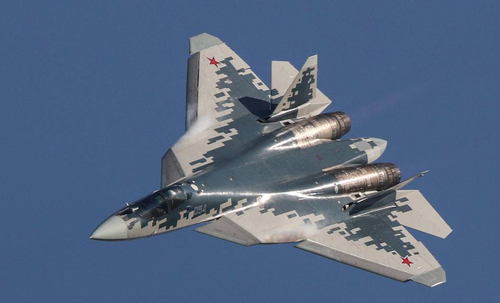See other World News Articles
Title: Russian Stealth Jet Tests Realistic Mockup Of New "Intra-Fuselage Hypersonic Missile"
Source:
[None]
URL Source: https://www.zerohedge.com/geopoliti ... ra-fuselage-hypersonic-missile
Published: Feb 22, 2021
Author: Tyler Durden
Post Date: 2021-02-22 00:30:23 by Horse
Keywords: None
Views: 118
Comments: 2
The superpower rivalry, sparked by the Cold War between the US and Russia, continues to this day. If that's in stealth fighter jets or hypersonic weapons, there's a race between both countries to field these weapons. Russia appears to be ahead in hypersonic weapon development as the US has yet to field these weapons. Still, the US is ahead of Russia when it comes to fielding stealth jets. The ultimate fighter jet is a fifth-generation fighter with a weapon bay that can carry hypersonic missiles. Both the US' Lockheed Martin F-35 Lightning II and Russia's Sukhoi Su-57 weapon bays are too small to carry hypersonic missiles. However, Russian defense industry sources told Sputnik News that the Su-57 is undergoing tests on its ability to carry hypersonic weapons internally. "Russian media reported earlier this week that a realistic mockup of a new "intra-fuselage hypersonic missile" was being carried by an Su-57 for test flights. The details of the weapon are vague; however, it is likely the same weapon reported to have been developed in February 2020," Sputnik said. At the moment, Russia's Mikoyan MiG-31 carries the Kh-47M2 Kinzhal, an air-launched hypersonic missile that can travel at Mach 10, on its belly. The Tupolev Tu-160 supersonic bombers can also carry the Kinzhal. With the Kinzhal measuring 26 feet long, and the Su-57's 14-foot-long internal weapons bay, Russia has embarked on a task to make the world's smallest hypersonic missile. SU-57's Weapons Bay No extant hypersonic weapon has been so small, as all have been the size of large cruise missiles or air-launched ballistic missiles," Sputnik said, adding that "such a weapon might be powered by an air-breathing scramjet, a type of advanced rocket engine used to attain ultra-fast speeds, such as that currently being developed by India." Ever since the Soviet Sputnik satellite entered orbit in 1957, both countries have been on a militarization path to gain an edge over one another. 
Post Comment Private Reply Ignore Thread
Top • Page Up • Full Thread • Page Down • Bottom/Latest
#1. To: Horse (#0)
With such a tiny economy, Russia does quite well to keep up as they do.
The US has so much graft and corruption in our government that Russia can spend 1/10th as much as the US and get better results. Dr Mark Skidmore will be updating his estimate of $21 trillion gone missing. Says it is now $35 trillion that has gone missing.
The Truth of 911 Shall Set You Free From The Lie
#2. To: Pinguinite (#1)
Top • Page Up • Full Thread • Page Down • Bottom/Latest